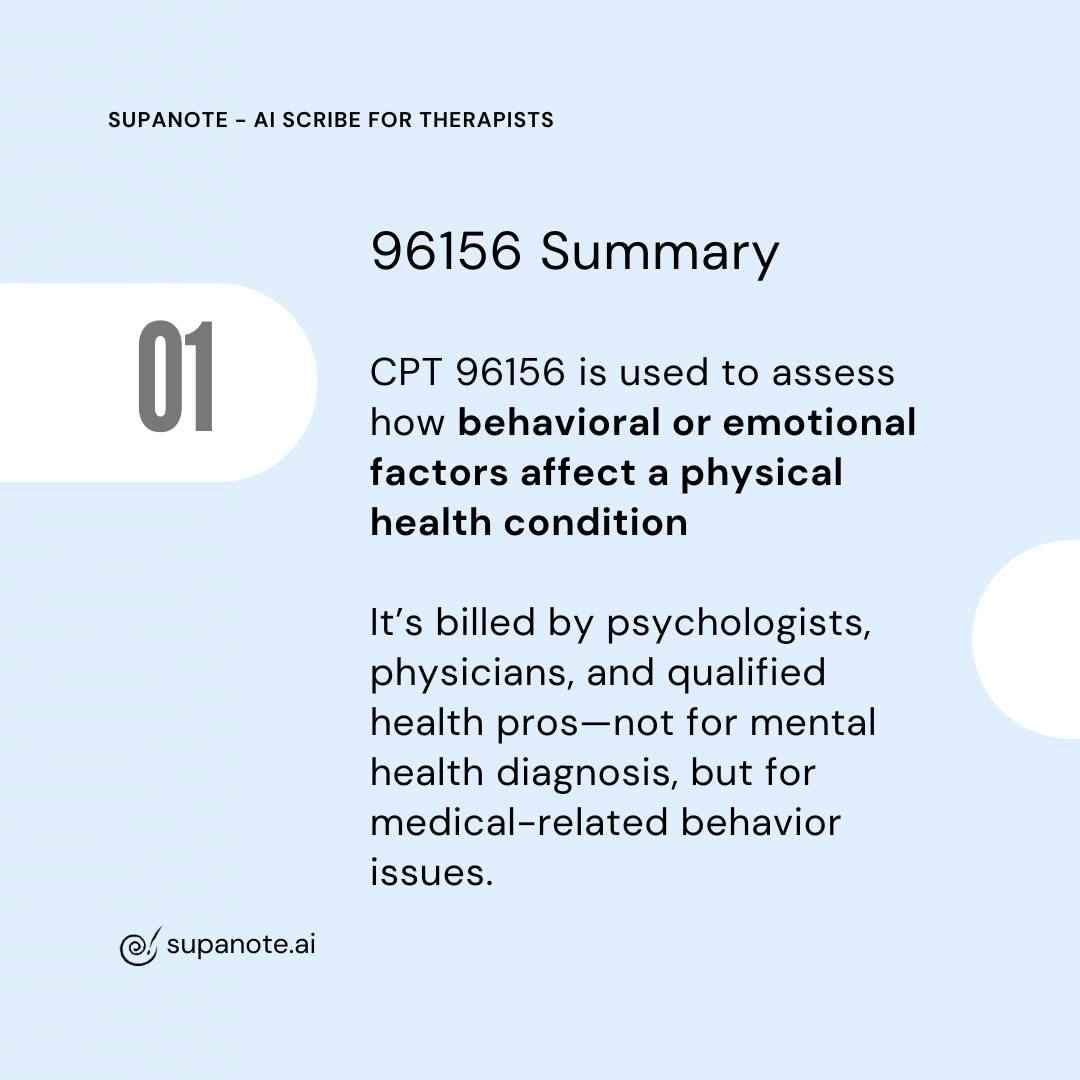That moment when a physician refers a patient with diabetes struggling with non-compliance. You know how to help, but how do you bill for it?
CPT code 96156 is the answer. Let’s break down everything you need to know about health behavior assessment in simple terms.
What is CPT Code 96156?
CPT code 96156 represents a “health behavior assessment or re-assessment.”
The American Medical Association established this current procedural terminology code to identify services that evaluate a range of psychological, behavioral, emotional, cognitive, and social factors affecting physical health conditions and their treatment.

This code supports:
- Identifying barriers to treatment compliance
- Evaluating a patient’s ability to manage health conditions
- Assessing factors impacting prevention efforts
- Determining cognitive and emotional responses to illness
- Developing targeted treatment planning for better outcomes
The services provided under CPT code 96156 must be accurately reported in accordance with established guidelines to ensure proper compliance and reimbursement.
When to Use This Code
The CPT code 96156 applies when you:
- Perform an initial assessment of health behaviors
- Conduct a re-assessment due to changing conditions
- Evaluate behavioral factors in treatment non-compliance
- Address psychological aspects of disease prevention
- Support patients struggling with medical procedures
- Identify behavioral barriers affecting medical outcomes
Unlike mental health evaluation codes, 96156 specifically requires a focus on physical health conditions and medical necessity related to those conditions.
The Assessment Process: What Happens During 96156
A typical health focused clinical interview includes:
- Gathering information provided by the patient about health behaviors
- Reviewing medical data to understand the physical condition
- Making behavioral observations related to health management
- Conducting standardized assessments if needed
- Integration of findings into clinical decision making
- Developing a report with clear recommendations
Industry trends show these assessments typically take 45-60 minutes, though the code itself isn't time-based. The National Correct Coding Initiative guidelines indicate this is billed as one unit per encounter regardless of time spent.
Documentation That Supports Claims
Your documentation must clearly address:
- The referring physician or provider
- Date of service and place of service
- Medical necessity linking to physical health condition
- Methods used in the assessment
- Behavioral observations and findings
- Impact on health outcomes
- Recommendations for intervention
- Provider signature with credentials
Thorough documentation not only supports accurate billing and modifier use, but also helps protect both patient and provider rights throughout the billing process.
Sample Documentation:
Referred by: Dr. Smith, Endocrinology
Medical Condition: Type 2 Diabetes (E11.9)
Purpose: Evaluate factors affecting treatment compliance
Procedures:
- Conducted health focused clinical interview
- Reviewed medical records from past 6 months
- Administered standardized measures for diabetes management
Behavioral Observations:
- Patient demonstrates significant diabetes-related distress
- Shows limited understanding of treatment requirements
- Reports difficulties with medication schedule
- Exhibits emotional responses when discussing complications
Clinical Decision Making:
Non-compliance with diabetes treatment directly related to emotional distress, knowledge deficits, and lack of support systems.
Recommendations:
- Six sessions of health behavior intervention focusing on compliance
- Education to improve understanding of treatment requirements
- Family session to address support needs
Medical Necessity: Intervention required to improve compliance with medical treatment and prevent complications.
Total time: 50 minutes
[Provider Signature, Credentials]
Try documentation that keeps up with you!
Automated, HIPAA-compliant Progress Notes so you can focus on your clients
Get Supanote for Free Now!
Related Codes for Complete Care
Understanding the expansion of behavior assessment and intervention codes helps with proper billing.
The American Medical Association update to these codes created a more logical coding structure. While 96156 represents the assessment, the related codes address the interventions that follow.
Here's a quick comparison of CPT Code 96156 versus some other similar CPT Codes.
Code | Description | Purpose |
|---|---|---|
96158 | Individual intervention | First 30 minutes of treatment |
96159 | Individual intervention add-on | Each additional 15 minutes |
96164 | Group intervention | First 30 minutes |
96167 | Family intervention | First 30 minutes |
Medicare Reimbursement and Billing Considerations
Current Medicare reimbursement ranges from $95-105 for 96156, though rates vary by:
- Geographic location
- Provider specialty and credentials
- Facility vs. non-facility settings
- Local coverage determinations
Best coding practices suggest verifying coverage before providing services. Psychologists and qualified health professionals who meet Medicare criteria can generally bill this code when supporting medical treatment.
Recent industry trends demonstrate increasing recognition of how behavioral health integration improves medical outcomes, expanding coverage for these services.
Seven Common Coding Practices to Avoid
Using 96156 without physical health focus
Wrong: Billing 96156 for anxiety without linking to a physical condition
Right: Billing 96156 for anxiety affecting asthma management
Insufficient medical necessity documentation
Wrong: "Patient has diabetes."
Right: "Patient's emotional responses are causing medication non-compliance."
Missing physical health diagnosis codes
Wrong: Only using behavioral diagnosis codes
Right: Listing the physical condition as primary diagnosis
Billing multiple units in one day
Wrong: Billing 2 units for an extended assessment
Right: Billing 1 unit per encounter regardless of time
Documentation without integration
Wrong: Separating physical and psychological findings
Right: Showing how behavioral factors directly impact health
Services performed by unqualified staff
Wrong: Delegating assessment to untrained personnel
Right: Ensuring qualified providers conduct the assessment
Billing assessment and intervention without clear separation
Wrong: Blending assessment and intervention in the same progress note
Right: Distinct documentation for each service when provided same day
Re-Assessment and Adjustment
Ongoing reassessment and adjustment are vital to the effective use of CPT code 96156. Providers should regularly conduct health behavior reassessments to evaluate patient progress, identify new or persisting barriers, and refine treatment plans as needed. This process involves updated health-focused clinical interviews, fresh behavioral observations, and renewed clinical decision making to ensure that services remain relevant and medically necessary.
Regular reassessment not only improves patient outcomes but also helps providers identify opportunities for service expansion and quality improvement.
By documenting each reassessment thoroughly and adjusting care plans accordingly, providers can ensure ongoing compliance, optimize billing, and deliver the highest standard of care.
Implementing Health Behavior Assessment: Practical Steps
- Train staff on proper assessment procedures
- Create documentation templates that address all required elements
- Establish physician referral relationships
- Verify insurance coverage before providing services
- Develop liability protections through solid documentation
- Monitor claims processing to identify reimbursement patterns
- Schedule regular chart reviews to ensure compliance with criteria
Automating Documentation for CPT 96156 with AI
Let’s be real, completing detailed documentation for CPT 96156 assessments can be time- consuming, especially when you're juggling back-to-back sessions. But here’s where AI can be your behind-the-scenes assistant.
Tools like Supanote allow you to automate your therapy notes by securely listening to your session and generating progress notes tailored to codes like 96156. Whether you're evaluating behavioral responses to chronic conditions or identifying compliance barriers, Supanote captures key clinical details in the format insurers expect.
With prebuilt templates like SOAP, DAP, GIRP and more, Supanote helps you to:
- Document medical necessity clearly
- Link psychological observations to physical health conditions
- Maintain clean separation between assessment and intervention notes
- Save time without compromising on compliance
By integrating AI into your workflow, you not only cut down on admin time—you also increase accuracy, streamline billing, and reduce the risk of denials.
Ready to try? 10 notes on us!
Login to your Supanote account and instantly access 10 free notes
Try Supanote for Free Now!
FAQs about CPT Code 96156
Q: Can I bill for assessment and intervention on the same day?
A: Yes, most insurers allow billing both 96156 and intervention codes (96158) on the same day if provided and documented separately.
Q: What diagnoses support 96156?
A: The primary diagnosis should be the physical health condition being addressed, with behavioral diagnoses as secondary when relevant.
Q: How does 96156 differ from previous coding systems?
A: The 2020 CPT update replaced the former 15-minute incremental billing with a single code for the entire assessment, simplifying the process.
Q: Which providers can bill 96156?
A: Psychologists, physicians, and other qualified health professionals with appropriate training can bill this code, though specific requirements vary by insurer.
Q: Is physician referral required?
A: While not universally mandated, physician referral demonstrates medical necessity and improves claim approval rates.
Q: Can these assessments be provided via telehealth?
A: Yes, with appropriate telehealth modifiers and according to current coverage guidelines.
Q: How often can I bill reassessment for chronic conditions?
A: Reassessment (96156) is typically covered every 3-6 months when documentation supports ongoing evaluation needs due to changes in condition or treatment response.
Helpful Resources
- American Psychological Association Health Psychology Division guidelines and information on health behavior practice
- National Correct Coding Initiative Policy Manual- Essential reference for understanding coding requirements
- CPT Assistant Archives- Articles providing official guidance on proper code application
As healthcare continues emphasizing prevention and comprehensive care, your ability to identify and address behavioral factors affecting physical health becomes increasingly valuable. Understanding CPT code 96156 helps you provide needed services while ensuring proper reimbursement for your expertise.
